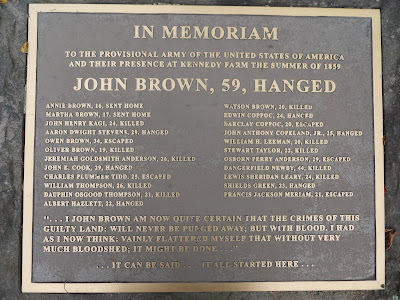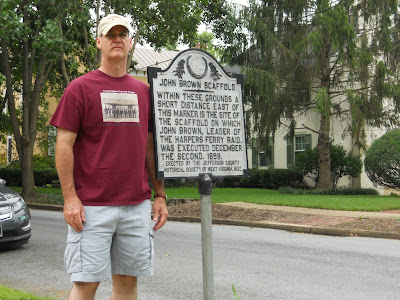As I posted on Thursday evening, I had the great fortune of attending the National Park Service historians August tour to Cool Springs Battlefield, where I got to see John Brown's trial judge, Richard Parker's, second home "Retreat." Later that day we also visited Belle Meade Plantation, which is just south of Winchester where we learned about the significant archaeology work going on there. This work is helping them to better tell the story of the enslaved that lived there in their programming.
Staying the night in Winchester, I got up early on Friday morning to do some John Brown raid site seeing in adjacent Jefferson County, West Virginia, and over across the Potomac River in Maryland, too. I did not visit the sites in the order they are presented here. Rather, I've place them in roughly in chronological order as they occurred during the raid.
I stopped at the Kennedy farmhouse (shown above), which Brown rented under the name of Issac Smith, in the summer of 1859. The log and stone building is about five miles or so from Harper's Ferry along a winding section of road. The headquarters/home has recently been restored and a couple of Civil War Trails waysides stand in the yard interpreting the events that swirled there in 1859, and later during the Civil War.
I visited the Kennedy Farm site about ten years ago. At that time a chain link fence kept visitors at a distance from the historic structure. But on this visit I had the opportunity to get an up close look at the home. On a large boulder between the house and the parking area by the road, the above memorial plaque lists the names, ages, and fates of Brown's small raiding force. The site is a National Historic Landmark and is available for tour by appointment. Interestingly, items left at the Kennedy Farm by the raiders were used as evidence in the trial in Charles Town after Brown and a number of his men were captured in Harper's Ferry and jailed at the county seat.
Between Harper's Ferry and Charles Town is Beallair, the period home of Lewis Washington, who was the great-grand nephew of George Washington. John Cook, one of Brown's raiders, had his made residence in the area to scout it out before the raid and determined that Washington would make a good hostage and his slaves would make recruits for the army the raiders were trying to build.
Lewis Washington was taken captive on the night of October 16 and moved to Harper's Ferry. John Cook and African American raider Osborne Perry Anderson were at the house, they took a sword that Frederick the Great had given George Washington and which had devolved to Lewis Washington.
Several dependency buildings, both attached (above) and detached (two below) are also on the property. I would guess that the building above was used for house slave quarters and the stone building below was likely the kitchen.
Another stone building sits just across the road. This may have served as other slave quarters or may have been a workshop of some type, as I do not remember seeing a chimney on the building. However, it may have been heated with a stove instead of fireplace/chimney.
All of the buildings are in good condition, and although housing development has encroached and certainly changed the landscape, it is good to know there is an effort to keep the original structures in place and in good repair.
After taking Washington and a handful of his slaves, Cook and Anderson moved on toward Harper's Ferry and stopped at Allstadt's Ordinary. At his home, tavern, and small inn along the turnpike the raiders took more hostages including John Allstadt, his teenage son John Thomas Allstadt, and seven of their slaves.
Several of the raiders and hostages ultimately ended up in the armory's fire engine house (shown above) in Harper's Ferry. The present site of the engine house is not where it originally stood. It has been moved at least four times since the 1859 events.
Near the original site of the fire engine house runs Hog Alley (shown above). It was here that free man of color and raider Dangerfield Newby was killed when hit with a projectile in the neck. Newby's body was first mutilated by townspeople and then left to be eaten by hogs. Thus the alley received its name.
Brown's trial was held at the Jefferson County courthouse (shown above). He was, of course, found guilty and sentenced to death by hanging.
Brown's last days were spent largely in the Jefferson County jail. Here, now the site of the town's post office, the chief raider received letters, visited with a both friends and enemies, and wrote to supporters of his abolitionist cause.
On December 2, 1859, Brown was taken to the city's southern outskirts where a gallows stood, constructed for the occasion. At shortly before noon, and before witnesses such as John Wilkes Booth and Thomas Jonathan Jackson, Brown was hanged. His hanging made him a martyr in abolitionist circles. And then the war came. It wouldn't be long before Union soldiers created the marching song known as "John Brown's Body."
If you travel to Jefferson County, West Virginia, be sure to stop by the Charles Town visitor's center and pick up a copy of their "John Brown's Trail" brochure, which give directions to all of the sites mentioned above.





















No comments:
Post a Comment